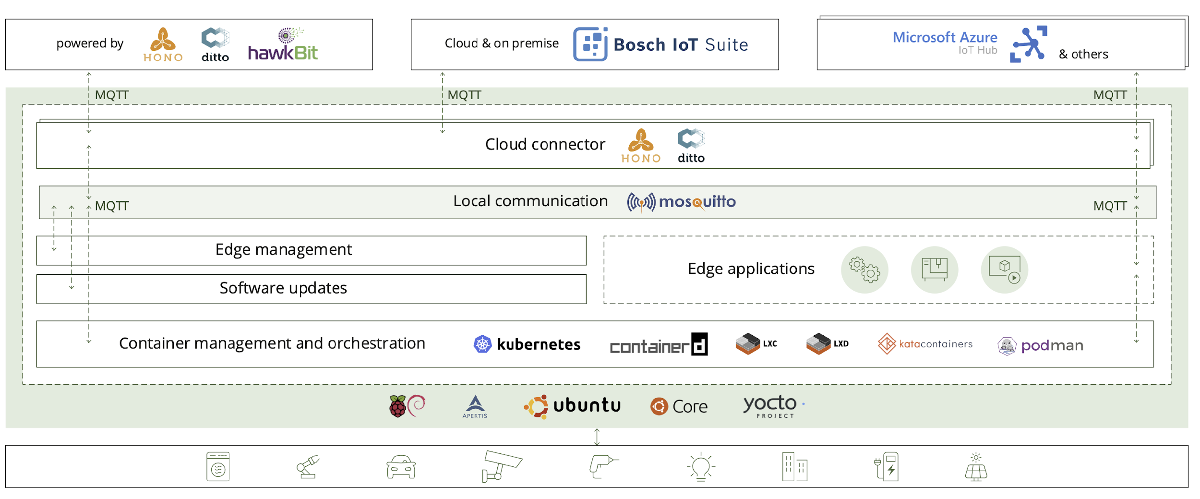The blend of artificial intelligence and IoT and the shift from cloud to edge have accelerated demand for edge computing capabilities. As individual companies across domains are tackling the same base-level edge computing challenges in their own way, a diversified landscape of devices, software, and hardware is emerging. The resulting diversity and disparity is making fast and seamless communications and operations at the edge extremely challenging.
The Eclipse Kanto project provides a modular IoT software stack for edge devices that resolves this complexity, empowering technology teams to build their next generation connected products simpler and faster.
Developers have access to an open ecosystem of technology building blocks they can use as needed to seamlessly interconnect with the wide variety of devices in today’s diverse edge landscape. Instead of losing time and energy to solve the complexity and reinvent the essentials by themselves, developers are free to focus on the differentiating application they’re developing. They never have to worry that the software that runs at the heart of their devices is locking them into a particular ecosystem or vendor. And they can benefit from the technology advances being made across multiple open source communities.
Eclipse Kanto is the result of more than 20 years of professional experience in the field of edge and IoT at Bosch.IO, incorporating knowledge from many market-proven commercial products launched by Bosch.IO. The Eclipse Foundation project is the open source culmination of that expertise.
Here are five key ways Eclipse Kanto accelerates IoT edge development.
1. All the Essentials in a Single Software Stack
Enabling an edge device for an IoT environment requires five things:
- Cloud connectivity
- Digital twins
- Local communication
- Container management
- Software updates
By including all these capabilities in a single, modular software stack, Eclipse Kanto allows all layers to be managed in an integrated manner. It also eliminates the need for developers to find, integrate, or develop these core features themselves.
Figure 1: Eclipse Kanto Technology Building Blocks

Here’s a closer look at how Eclipse Kanto is leveraging a growing ecosystem of open standards and technologies to provide everything developers need in a single stack.
Figure 2: The Eclipse Kanto Open Ecosystem

2. Designed for Resource-Constrained Environments
Because Eclipse Kanto is built with lightweight native components, it’s well-suited to deployment in resource-constrained environments with:
- Limited hardware resources
- Real-time or near real-time requirements
- Diverse device software
- Heterogeneous data sources
Eclipse Kanto can also operate without a cloud connection, supporting configurable connectivity recovery and synchronization mechanisms to handle unreliable internet connection.
3. Lightweight Containerization Enables Scalable Edge Applications
Eclipse Kanto’s lightweight technologies enable the containerization of workloads. This allows it to function as a plug-and-play solution in heterogeneous IoT environments. Eclipse Kanto can operate on its own or it can be integrated into a pre-existing AIoT environment without difficulty.
With Eclipse Kanto, edge applications packaged into Open Container Initiative (OCI) containers can be deployed on the device to ensure better isolation, reliability, availability, and dependency management. Eclipse Kanto can be easily integrated with most fit-for-purpose container management runtimes, including containerd, Podman, and Kata Containers, among others.
4. Cloud-Agnostic Connectivity Enables Flexible Edge Management
Eclipse Kanto can connect to most public IoT platforms. And because it uses common APIs, it enables device and device data management, locally and from the cloud, with minimal customization, allowing for faster prototyping. This is further aided by robust device-side client SDKs and libraries for different languages.
5. Modular Architecture Accommodates Flexible Integrations for Diverse Use Cases and Domains
Because Eclipse Kanto is modular by design, developers can use as many, or as few, of its capabilities as needed. This flexibility and scalability mean Eclipse Kanto can be used in a variety of environments to support diverse use cases.
Here are just a few examples:
Software-defined vehicles
Eclipse Kanto can be used as the basis of the software stack for the QM domain in vehicles, transforming vehicles into connected IoT devices. Eclipse Kanto features such as cloud connectivity, digital twins, software updates, and container management are particularly relevant to enable deployment of containerized in-vehicle applications in QM as well as seamless management in-vehicle software across different domains and complex vehicle hardware setups.
Connected homes and smart buildings
Eclipse Kanto can be deployed on typical gateway platforms, such as Raspberry Pi, Beagle Bone, and more. From there it can be connected to backend of choice and equipped with containerized applications to control various devices and systems in the home.
In the same way, Eclipse Kanto can manage multiple gateways in connected buildings, enabling various smart building services like building insights, intelligent building management, and more.
Connected machines and smart manufacturing
In industrial environments, Eclipse Kanto can be used to collect performance and health data from connected machines and assets to react locally or send it to a backend of choice for further analysis, thus enabling various anomaly detection and predictive maintenance use cases.
Watch for Next Steps and Learn More
Eclipse Kanto’s first milestone release is already available for you to try it out! You can download it and follow the getting started guide.
Consequent contributions, a public roadmap, and a regular public event to steer Eclipse Kanto’s technology development and community are coming very soon!
To find out more:
- Visit the project website to read up on progress and what Eclipse Kanto is all about.
- Visit our GitHub to get your hands on the sources and try out our very first milestone release.
Sign up for the mailing list to receive the latest updates, news, and event information.




